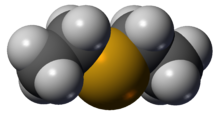
| |
| Names | |
|---|---|
| Preferred IUPAC name (Ethylsulfanyl)ethane | |
Other names
| |
| Identifiers | |
| CAS Number | |
| 3D model (JSmol) | |
| Beilstein Reference | 1696909 |
| ChEBI | |
| ChEMBL | |
| ChemSpider | |
| ECHA InfoCard | 100.005.934 |
| EC Number |
|
| Gmelin Reference | 1915 |
| KEGG | |
| PubChem CID | |
| RTECS number |
|
| UNII | |
| CompTox Dashboard (EPA) | |
InChI
| |
SMILES
| |
| Properties | |
| Chemical formula | (CH3CH2)2S |
| Molar mass | 90.18 g·mol |
| Appearance | Colorless liquid |
| Odor | Unpleasant |
| Density | 0.837 g/cm |
| Melting point | −103.8 °C (−154.8 °F; 169.3 K) |
| Boiling point | 92 °C (198 °F; 365 K) |
| Solubility in water | insoluble |
| Solubility in ethanol | miscible |
| Solubility in diethyl ether | miscible |
| Magnetic susceptibility (χ) | −67.9·10 cm/mol |
| Refractive index (nD) | 1.44233 |
| Hazards | |
| Occupational safety and health (OHS/OSH): | |
| Main hazards | Skin and eye irritant. Highly flammable liquid and vapor |
| GHS labelling: | |
| Pictograms |  
|
| Signal word | Danger |
| Hazard statements | H225, H315, H319 |
| Precautionary statements | P210, P233, P264, P280, P303+P361+P353, P370+P378 |
| NFPA 704 (fire diamond) |
 |
| Flash point | −10 °C (14 °F; 263 K) |
| Safety data sheet (SDS) | External MSDS |
| Related compounds | |
| Related thioethers | |
| Except where otherwise noted, data are given for materials in their standard state (at 25 °C , 100 kPa).
| |
Diethyl sulfide (British English: diethyl sulphide) is an organosulfur compound with the chemical formula (CH3CH2)2S. It is a colorless, malodorous liquid. Although a common thioether, it has few applications.
Preparation
Diethyl sulfide is a by-product of the commercial production of ethanethiol, which is prepared by the reaction of ethylene with hydrogen sulfide over an alumina-based catalyst. The amount of diethyl sulfide produced can be controlled by varying the ratio of hydrogen sulfide to ethylene.
Occurrence
Diethyl sulfide has been found to be a constituent of the odor of durian fruit and as a constituent found in volatiles from potatoes.
Reactions
Diethyl sulfide is a Lewis base, classified as a soft ligand (see also ECW model). Its relative donor strength toward a series of acids, versus other Lewis bases, can be illustrated by C-B plots.
With bromine, it forms a salt called diethylbromosulfonium bromide:
- (CH3CH2)2S + Br2 → [(CH3CH2)2SBr]Br
A typical coordination complex is cis-PtCl2(S(CH2CH3)2)2.

References
- "GESTIS-Stoffdatenbank". gestis.dguv.de (in German).
- Baldry, Jane; J. Dougan; G. E. Howard (1972). "Volatile Flavouring Constituents of Durian". Phytochemistry. 11 (6): 2081–2084. Bibcode:1972PChem..11.2081B. doi:10.1016/s0031-9422(00)90176-6.
- Gumbmann, M. R.; H. K. Burr (1964). "Food Flavors and Odors, Volatile Sulfur Compounds in Potatoes". Journal of Agricultural and Food Chemistry. 12 (5): 404–408. Bibcode:1964JAFC...12..404G. doi:10.1021/jf60135a004.
- Laurence, C. and Gal, J-F. Lewis Basicity and Affinity Scales, Data and Measurement, (Wiley 2010) pp 50-51 ISBN 978-0-470-74957-9
- Cramer, R. E.; Bopp, T. T. (1977). "Graphical display of the enthalpies of adduct formation for Lewis acids and bases". Journal of Chemical Education. 54: 612–613. doi:10.1021/ed054p612. The plots shown in this paper used older parameters. Improved E&C parameters are listed in ECW model.
- Scott A. Snyder, Daniel S. Treitler (2011). "Synthesis of Et2SBrSbCl5Br and Its Use in Biomimetic Brominative Polyene Cyclizations". Organic Syntheses. 88: 54. doi:10.15227/orgsyn.088.0054.
- C.Hansson (2007). "cis-Dichloridobis(diethyl sulfide-κS)platinum(II) at 295 and 150 K". Acta Crystallographica Section C. 63 (Pt 8): m361-3. Bibcode:2007AcCrC..63M.361H. doi:10.1107/S0108270107030417. PMID 17675684.